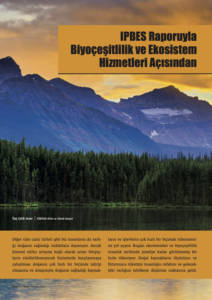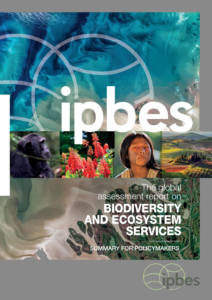Turkey hosts a large number and variety of species in its diverse marine and coastal habitats. Marine ecosystems, by their biodiversity, ecosystem functions and services, provide many environmental, social and economic values and benefits. Marine Protected Areas are of major importance for the preservation of marine ecosystems and inherent marine biodiversity.
Turkey’s Marine Biodiversity
OUR SEAS:Surrounded by seas on three sides, Turkey has coasts to four seas, namely Black Sea, Marmara, Aegean and Mediterranean(Levantine) seas. All those diverse seas and coasts boast rich marine biodiversity, forming habitats that host many marine creatures including invertebrates, vertebrates and macrophytes.
The number of marine species tend to diminish as we go from the Mediterranean to the Black Sea. Among Turkish seas, the Mediterranean has the highest salinity and temperature. The Mediterranean hosts species of Atlantic and Indo-Pacific origin in addition to its native species. The Aegean Sea features many diverse habitats on account of its many bays, coves, and peninsulas. The Aegean Sea and its islands represent diverse habitats including those dominated by seagrasses and algae (Posidonia oceanica, Cystoseira spp., coralligenous, etc.). The Marmara Sea is an inland sea lying between the Aegean and Black Seas, harbouring species both from these environments. The Marmara further serves both as a barrier or a biological corridor for species of the Mediterranean and Black Sea origins. The Black Sea has a lower salinity level, and possesses only 20% of total number of species living in the Aegean and Mediterranean Seas. The Black Sea on the other hand contains important fish species both in terms of biodiversity and economic value.
Studies to date suggest that on the coasts of Turkey, approximately 5,000 plant and animal species have been reported.
FISH: Turkish waters host 388 fish species in the Mediterranean, 389 in the Aegean Sea, 249 in the Sea of Marmara and 151 in the Black Sea. Of the 472 fish species identified, 50% are believed to be at risk of decline due to anthropogenic threats.
MARINE MAMMALS:Turkish waters host the following marine mammals: Mediterranean monk seal (Monachus monachus), Short-beaked common dolphin (Delphinus delphis), Bottlenose dolphin (Tursiops truncatus), Harbour porpoise (Phocoena phocoena), Striped dolphin (Stenella coeruleoalba), Risso’s dolphin (Grampus griseus), False killer whale (Pseudorca crassidens), Long-finned pilot whale (Globicephala melas), Cuvier’s beaked whale (Ziphius cavirostris), Fin whale (Balaenoptera physalus), Sperm whale or cachalot (Physeter macrocephalus).
KEY SPECIES AND ENDANGERED SPECIES: Islands, coastal dunes, sea caves, coastal lagoons host many key species as well as endangered plant and animal species. Coastal dunes and beaches on the Mediterranean and South Aegean are breeding grounds for endangered Loggerhead sea turtle (Caretta caretta) and green sea turtle (Chelonia mydas) species. Islands along the Aegean and Mediterranean Seas offer critical habitats and breeding grounds particularly for seabirds. For example, the Audouin’s gull (Larus audouinii) and Eleonora’s falcon (Falco eleonorae) are important species that live in such areas. Islands and sea caves provide habitats and breeding grounds for the endangered Mediterranean monk seal (Monachus monachus).
THREATS:Turkey’s marine biodiversity is under threat due to the destruction of marine ecosystems and habitats, and over-exploitation of marine resources.
- Habitat loss and degradation
- Alien species
- Over-exploitation (hunting, trawling, ghost fishing, illegal fishing)
- Aquaculture
- Pollution (of terrestrial origin etc.)
- Sedimentation
- Climate change (sea warming)
- Change of hydrology
- Dredging
- Coastal erosion
Benefits of Marine Ecosystems
The nature and its benefits to human beings are essential for human existence and well-being. Such benefits are the very foundation of our food security, health and quality of life, livelihoods and economies. Such benefits as provided to human beings by natural ecosystems are collectively called ecosystem services.
“The Millennium Ecosystem Assessment” defines ecosystem services as supply, supporting, regulatory and cultural services. IPBES on the other hand introduced the more inclusive “Nature’s Contributions to People” instead of ecosystem services, in an effort to better understand the relation and interaction between the nature and human beings.
Marine ecosystems, by their biodiversity, ecosystem functions and services, provide many environmental, social and economic values and benefits, including but not limited to the following:
- Marine species offer food, energy, materials of direct or post-processing use, medicinal and genetic resources.
- Marine ecosystems preserve fish stocks, and provide healthy and safe food.
- Marine ecosystems constitute and sustain habitats for marine species.
- Sea grasses also known as the lungs of seas sequester and store carbon to regulate the climate.
- Sea grasses limit the impact of marine water movements, keep the sediments in seas, and reduce wave energy by their dead leaves and roots accumulating along the shores, all of which help control coastal erosion.
- Marine species purify waters by using nutrients within wastewater.
- Marine ecosystems support fishing, sea tourism and recreation, contribute to livelihoods.
- Marine ecosystems offer opportunities of interaction between seas and human beings in the form of nature observation, swimming, diving, stress release, as well as intellectual and representational interactions in the form of inspiration, learning, belonging, arts, cultural heritage etc. all of which contribute positively to human health and quality of life.
Marine Protected Areas (Key Marine Biodiversity Areas)
Turkey’s coastline stretches 8,592 km excluding islands. While Marine Protected Areas are not defined in the legislation in Turkey, they are nevertheless protected under various protection status by the Ministry of Environment and Urbanization and Ministry of Agriculture and Forestry. Of the Turkish coastline, 2,083 km is under protection (24% of the total). Marine protected areas cover 1,495,513 hectares.
What is a Marine Protected Area? Marine Protected Areas may be established for various purposes in various types and sizes, and managed in different ways. Therefore, no single definition exists for Marine Protected Areas. The simplest definition refers to protecting a certain marine area against human impact and preserving its natural, historical and cultural characteristics. Such protection is effected by laws and usually by the support and engagement of local people and stakeholders.
Why do we need Marine Protected Areas?Marine Protected Areas are indicators of healthy seas, species and habitats. Well-designed and managed Marine Protected Areas contribute to the social, cultural and economic well-being of the inhabitants with the protection of natural resources they offer.

